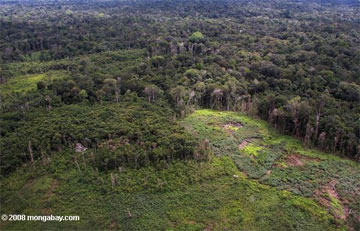Rich nations could offset CO2 emissions at $2/ton via rainforest conservation
Rainforest conservation could offset 500m tons of CO2 emissions at $2/ton
mongabay.com
July 24, 2008
|
|
Industrialized nations could collectively offset 500 million tons carbon of dioxide emissions at roughly $2 per ton by protecting tropical rainforests, according to estimates published in the online edition of Proceedings of the National Academy of Sciences.
The calculations, based on three different forestry and land-use models, provide an estimate of what developed nations would need to spend to participate in an “avoided deforestation” program to cut global carbon emissions. Avoided deforestation — also known as “Reducing Emissions from Deforestation and Degradation” (REDD) — has been widely lauded for its capacity to simultaneously fight climate change, protect the environment, and deliver economic benefits to poor rural populations.
“Compared to other options, an avoided deforestation program would be relatively cheap and practical for the United States,” said Brent Sohngen, a study co-author and professor economics at Ohio State University. “It would save American taxpayers money and provide a huge transfer of funding from one region of the world to another, giving developing countries a larger chunk of the world’s economic pie to use as they see fit.”

|
The models suggest that carbon dioxide credits costing $20 per metric ton of CO2 would result in average global carbon dioxide emission reductions of between 1.6 billion and 4.3 billion metric tons of carbon dioxide per year, while a $100 price — more than twice the current price of emissions credits traded in the European market — would reduce emissions 3.1 billion and 4.7 billion metric tons of carbon per year. Looking at the models in another way, the researchers estimate the carbon price needed to meet certain avoided deforestation targets.
“The cost to achieve a 10 percent reduction in global deforestation through 2030, resulting in between 0.3 billion and 0.6 billion metric tons of reduced carbon emissions annually, would cost between $2 and $5 per metric ton of carbon credit — or between $0.4 billion and $1.7 billion per year,” explained a release from Ohio State University. “Achieving a 50 percent reduction in deforestation, and a corresponding 1.5 billion to 2.7 billion metric ton reduction in emissions each year, would cost $10 to $21 per metric ton, or between $17.2 billion and $28 billion per year, according to the model calculations.”
The authors also looked at how the carbon market would affect land prices in the tropics. They found that carbon prices of $2 per ton of CO2 could translate into land rental values of $20-$35 per hectare per year for standing forests, while a carbon price of $10 per ton of CO2 would result in rental values of $85-$252 per hectare per year.

|
“Agricultural rents at the margin of infrastructural improvements (e.g., along new roads in newly accessed regions), where most deforestation occurs, are quite often lower than these estimates, suggesting that in many cases carbon payments could provide powerful economic incentives for reducing deforestation,” write the authors, noting that about 13 million hectares of tropical forest are lost each year according to U.N. estimates.
“These payment levels could generate substantial financial flows to landowners who reduce deforestation,” Sohngen said. “If this kind of program could stop deforestation, it would provide a bigger source of biodiversity by retaining a larger stock of tropical forest, keep carbon out of the atmosphere, and provide money to people in developing countries to pursue new forms of livelihood that don’t involve cutting down trees.”
Deforestation accounts for about 20 percent of anthropogenic carbon dioxide emissions.
Georg Kindermann, Michael Obersteiner, Brent Sohngen, Jayant Sathaye, Kenneth Andrasko, Ewald Rametsteiner, Bernhard Schlamadinger, Sven Wunder, and Robert Beach (2008). Global cost estimates of reducing carbon emissions through avoided deforestation. PNAS published July 23, 2008, doi:10.1073/pnas.0710616105
Related articles
Reducing deforestation rates 10% could generate $13B in carbon trading under REDD February 25, 2008
Cutting global deforestation rates 10 percent could generate up to $13.5 billion in carbon credits under a reducing emissions from deforestation (“REDD”) initiative approved at the U.N. climate talks in Bali this past December, estimate researchers writing in Philosophical Transactions of the Royal Society B. But the researchers caution there are still substantial obstacles to overcome before carbon-credits-for-rainforest-conservation becomes a reality.
Carbon trading could protect forests, reduce rural poverty February 26, 2008
Carbon trading from avoided deforestation (REDD) credits could yield billions of dollars for tropical countries, according to analysis by mongabay.com, a leading tropical forest web site. Using conservative estimates for carbon storage in tropical forests for 63 countries, mongabay.com estimates that reducing deforestation by 10 percent would generate $767 million to $4.6 billion per year at carbon prices ranging from $5-30 per ton of CO2 [tCO2e].
Avoided deforestation could help fight third world poverty under global warming pact October 31, 2006
Avoided deforestation will be a hot point of discussion at next week’s climate meeting in Nairobi, Kenya. Already a coalition of 15 rainforest nations[1] have proposed a plan whereby industrialized nations would pay them to protect their forests to offset greenhouse gas emissions. Meanwhile, last month Brazil — which has the world’s largest extent of tropical rainforests and the world’s highest rate of forest loss — said it will promote a similar initiative at the talks. At stake: potentially billions of dollars for developing countries and the future of the world’s climate.
More REDD news